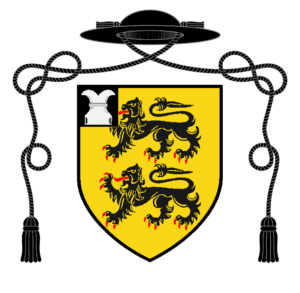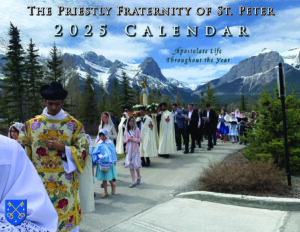Jewel of the Soul – A Short Review
by Fr. William Rock, FSSP

As a going away present, one of the families of Regina Caeli parish in Houston, Texas gifted me both volumes of the recently published translation of Honorius Augustodunensis’s Jewel of the Soul published by Dumbarton Oaks Medieval Library. I was very excited to receive it, having seen the review posted on the New Liturgical Movement blog. The family asked that I provide a review of the work. As such, this post is a response to their request.
To begin with, this work is a liturgical commentary, with a heavy emphasis on the allegorical or spiritual interpretation of the rites. The author himself was a “priest, monk, and hermit active in southern Germany and Austria” who died around 1140.1 According to the first paragraph of the introduction:
Honorius Augustodunensis’s Gemma animae, or Jewel of the Soul, stands out among the treatises of the pre-Scholastic blossoming of commentary on the Franco-Roman liturgical rite. Building on the work of Alamar of Metz (775-850), who wrote during the formative state of this rite, the Jewel is a liturgical encyclopedia, a rhymed-prose summa that explains the sacred mysteries of the Latin Church for clerics. It was read and imitated widely in the twelfth and thirteen centuries as the major authority on the liturgy, only superseded by William Durand’s Rationale divinorum officiorum (1291-1292), a work deeply indebted to it.2
According to the publisher’s website, this is “the first complete translation into a modern language” of this work.
In the translation, the first volume contains the Dedicatory Letters, Preface, and the first two Books. The first Book treats mainly on the Mass, the second on the Divine Office. The second volume contains Book 3, Book 4, and the Valediction. Books 3 and 4 both deal with the days of the liturgical year, with Book 3 addressing each individually and Book 4 ambitiously attempting to harmonize them so that they tell an overarching historical story over the course of the Church’s year, starting with Genesis and creation, even if some of the days symbolize both events or moments from the Old Law (“Under the Law”) and from the New Law/the Age of the Church (“Under Grace”). Throughout, the original Latin is presented on the lefthand pages, with the English translation on the right.

Overall, this work is no doubt a jewel, but I do have a few criticisms of the publication. The first is that there did not seem to be a consistent standard as to when something would be kept in the Latin in the translation, such as the names of prayers. There were some instances where I expected the Latin name to be given but a translation was provided instead, when, in other similar situations, the Latin would be provided. Also, as Honorius based his work on ceremonies of the Franco-Roman liturgy he was familiar with, they differ in certain respects from what was promulgated in the Roman books following the Council of Trent. I would have appreciated it if diagrams had been provided by the translators illustrating what Honorius was describing where the ceremonies differ. This would also be of benefit for those with little or no familiarity with the traditional Roman Rite. But, to be fair, the notes do explain certain things, such as the non-Roman practice of the bishop blessing the faithful before the distribution of Communion.3 Considering, however, the work as a whole, these criticisms are relatively minor.
One positive thing which I would like to note is that I was struck by the militaristic interpretations of the rites. Honorius strongly viewed the Crucifixion as a battle waged between Christ and the Devil, with Christ emerging victorious and thereby freeing man from sin and death (what is called today the Christus Victor model of the atonement). Based on the unity of the Mass and the Sacrifice of the Cross, Honorius viewed the Mass as an expression of this battle with the Priest entering into combat in Christ’s place (e.g. I.44, I.72). This understanding served as the foundation for one vein of liturgical interpretation presented in the Jewel. While understanding the Cross as a combat predates this time, and is expressed in the liturgy itself,4 such an interpretation of the liturgy would have been eagerly received by Honorius’s contemporaries as the Christian success of the First Crusade (1096–1099), with its capturing of Jerusalem and the establishment of the Crusader States, was a recent event. It should also be noted in this regard that the 1100s and 1200s were, perhaps, when chivalry reached its height.5 The contemporary social and political situation also served as another foundation used by Honorius with the feudal, hierarchical arrangement of society and the current manner of warfare serving as a complementary lens for interpretation so that, for example, the bishop could be seen as a victorious emperor (I.73), the cantors as military captains (I.76), and the assembled faithful as an army arranged for spiritual battle (I.75). Similarly, the rites are also viewed as the service of soldiers in the presence of and for the benefit of their Divine King (e.g., II.1). This militaristic vein of interpretation would no doubt serve well those who have a more combative disposition but also, and more importantly, help restore a proper masculine spirit to the Church’s rites.

From my reading, while this militaristic mode of interpretation can be found in William Durand’s work (d. 1296), it is infrequently used. In a similar way, while Durand’s contemporary St. Thomas Aquinas (d. 1274) does not deny that in some way man was rescued from the domination of the devil when he discusses Christ’s Passion, he mostly focuses on the Satisfaction model of the atonement where Christ made, by His voluntary sacrifice, satisfaction to the justice and honor of God, thereby paying the debt to God man incurred by sin (S.T. III, q. 48, a. 4).6 It is worth noting in this regard that a shift occurred with the theology of St. Anselm of Canterbury (d. 1109) who proceeded “from the contemplation of the guilt of sin,” which demands an infinite expiation, while those before him proceeded “more from the contemplation of the consequences of the Redemption, and therefore stress[ed] the negative side of the Redemption, namely the ransoming from the slavery of sin and of the Devil.”7 This shift may explain why combat themes are more prominent in the comparatively earlier writing of Honorius and not in the comparatively later writings of Durand and Thomas.
In closing, I would heartly recommend this work to those who are interested in approaching the Latin Liturgy, and the Mass in particular, in the same way as our Catholic forefathers, especially embracing an allegorical outlook. It would also serve well those who seek to practice their Faith in a more militaristic, chivalrous manner, in the manner of a knight, in the manner of a crusader.
Fr. William Rock, FSSP was ordained in the fall of 2019 and is currently assigned to St. Stanislaus Parish in Nashua, NH.
In support of the causes of Blessed Maria Cristina, Queen, and Servant of God Francesco II, King
- Honorius Augustodunensis. Jewel of the Soul, vol 1. Trans Thomas, Zachary and Eger, Gerhard. (Cambridge: Harvard University Press – Dumbarton Oaks Medieval Library, 2023), p. vii.
- Ibid.
- Ibid., p. 583, n. 60.1.
- Such as in the Preface of the Holy Cross (most likely 8th Century, Alcuin of York) – “Qui salútem humáni géneris in ligno Crucis constituísti: ut, unde mors oriebátur, inde vita resúrgeret: et, qui in ligno vincébat, in ligno quoque vincerétur / Who didst establish the salvation of mankind on the tree of the Cross; that whence death came, thence also life might arise again, and that he, who overcame by the tree, by the tree also might be overcome” – and the Easter Sequence [Ascribed to Wipo, 11th Cent.] – “Mors et vita duéllo conflixére mirándo: dux vitæ mórtuus regnat vivus. / Death and life contended in that conflict stupendous: the Prince of Life, who died, deathless reigneth.”
- Chivalry | Definition & Examples | Britannica.
- The Satisfaction model also has support in the Liturgy, such as in the Exsultet (5-7th Century) of the Easter Vigil which has the text: “Qui pro nobis ætérno Patri Adæ débitum solvit: et véteris piáculi cautiónem pio cruóre detérsit. / [Christ] Who for our sake paid Adam’s debt to the eternal Father, and, pouring out His own dear Blood, wiped clean the record of our ancient sinfulness.” Indeed, the Roman Canon itself, codified for all intents and purposes by St. Gregory the Great (d. 604), presents the Sacrifice of the Mass, and thus the Sacrifice of the Cross, as being the offering of the Son to the Father.
- Ott, Ludwig. Fundamentals of Catholic Dogma. Trans. Lynch, Patrick. Edited by Bastible, James. Updated by Fastiggi, Robert. (Baronius Press, 2018), p. 204.
October 22, 2024









